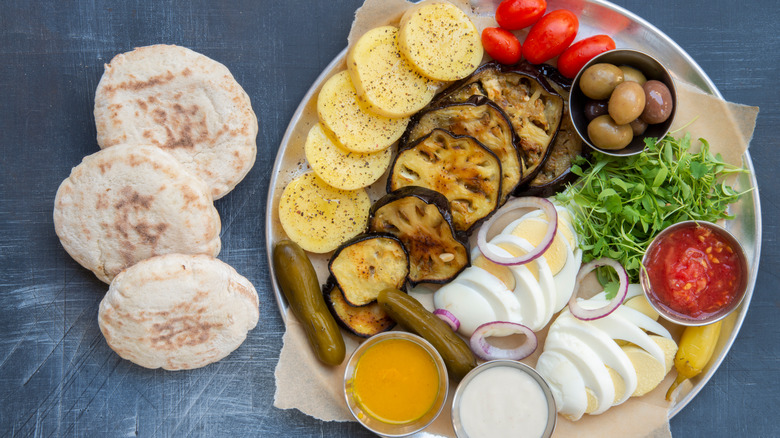Sabich Is The Popular Middle Eastern Fried Eggplant Sandwich
The nation of Israel is a relatively new country, formed during the 1940s as a refuge for European and Middle Eastern Jews who'd been fleeing persecution as early as the turn of the 20th century. Consequently, Israeli cuisine is a cultural melting pot of culinary traditions from Europe, the Mediterranean, and the Middle East.
Sabich is one such Israeli-claimed tradition that coincides with the formation of the Jewish state and represents a Middle Eastern contribution to Israel's culinary diversity. Originally an Iraqi Jewish tradition, Sabich is a hearty breakfast sandwich that arrived in Israel during the '40s and '50s.
Iraqi Jews would prepare various dishes in advance and use them along with other cold leftovers to make a quick breakfast that has now become one of Israel's most popular street foods. The original sandwich consists of Iraqi laffa (unleavened flatbread) filled with cold leftovers of fried eggplant, hard-boiled eggs, salad, tahini, parsley, and a mango sauce called amba.
An Iraqi-Israeli immigrant took this culinary tradition out of the home and into a Tel Aviv street stall in 1961, and Sabich has since proliferated to stalls, fast food restaurants, and brunch spots around Israel. It's as ubiquitous a Jewish food as hamin or falafel.
How Sabich is made
Sabich is a cold sandwich because its fillings are made in advance. You'll see street stalls with numerous Tupperware compartments filled with all the premade fix-ins. Fried eggplant offers a rich and earthy flavor with a soft, melt-in-your-mouth texture.
The hard-boiled eggs come from a Shabbat stew called Hamin in which eggs braise for hours in a meaty, aromatic broth, dyeing the whites a dark brown. The salad consists of diced tomatoes, onions, bell pepper, and cucumber, which is one of Israel's national dishes.
Sabich, like most Mediterranean and Middle Eastern dishes, is heavily elaborated with various condiments, spreads, and garnishes including, hummus, tahini sauce, chopped parsley, and amba. Tahini sauce is a simple mixture of tahini, garlic, and lemon juice. Amba is a pickled mango sauce, consisting of sour green mango, vinegar, and various South Asian spices.
Boiled potatoes are another popular filling for added heft that has been around since Sabich's inception, but aren't always included. Over the past 70 years, Israelis have added and swapped ingredients from the original recipe, making it a more customizable breakfast sandwich and street food.
Sabich variations and modifications
Sabich is a veritable kitchen-sink sandwich, containing a wealth of stand-alone ingredients and sauces wrapped neatly inside flatbread. The original recipe uses Iraqi laffa, which is often swapped for leavened Israeli pita bread. Other modifications include the addition of Zhug, a zesty, spicy, chutney-like green sauce made with parsley, cilantro, chilies, garlic, spices, and olive oil.
Common additions to the sandwich include avocado, pickles, pickled red onion, chopped chili peppers, and pickled beets. Braised eggs are common, but regular boiled eggs are becoming the new normal. If you make it at home, you could make jammy eggs for a creamy, runny texture.
Sabich has gone from a quick breakfast sandwich assembled at home to a fast street food sandwich to enjoy on the go. But now, it's a popular menu item at sit-down restaurants for leisurely weekend brunches.
You can get them as sandwiches at restaurants or Sabich salad, a deconstructed version of the Sabich sandwich that removes the pita or laffa and replaces it with a colorful plate of Israeli salad, hummus, braised boiled eggs, fried eggplant, and boiled or french fried potatoes. Some restaurants even offer buffet-style compartments of numerous veggies, salads, sauces, and garnishes for customers to personalize a Sabich salad or sandwich.


